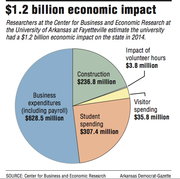The University of Arkansas at Fayetteville contributed $1.2 billion to the state's economy last year, according to the university's Center for Business and Economic Research.
The $1.2 billion total for fiscal year 2014 includes $236.8 million in one-time construction costs. The other $975.6 million is considered by report authors to be a recurring annual economic impact. Of the $1.2 billion total, $932.3 million of the economic impact is concentrated in Northwest Arkansas, the report states.
The report, released by UA on Tuesday, comes during a legislative session. Lawmakers will decide how much funding to give public entities, including UA.
In an interview, UA Chancellor G. David Gearhart acknowledged that the state Legislature is one intended audience for the report.
"We hope that they are proud of the fact that their flagship university is providing economic development for the whole state," Gearhart said, adding, "our hope is that at some point the General Assembly will recognize that an investment in the university is an investment in Arkansas."
Such studies have drawn criticism from some economists who have faulted public universities for exaggerating some of their economic influence.
The study marks the second time UA has analyzed its economic impact, with the total announced Tuesday a 66 percent increase compared with a report finding a statewide impact of $725.4 million in 2009.
Gearhart noted that UA has "grown immensely the last few years." Enrollment has increased by more than 7,000 students since 2008, climbing to 26,237 as of fall 2014. The report states there are now nearly 300 more faculty members at UA than what was reported in the study published in 2010. Payroll totaling $317.9 million increased by $71.4 million since the previous study, with UA now employing 1,352 faculty and 3,108 staff members, according to the report.
The study examined not only UA's direct spending but also indirect and induced effects. An example of these secondary effects would be the hiring done by an educational supply company providing services to UA.
Surveys helped researchers estimate that UA students spend $307.4 million annually on items such as housing, food and entertainment and that visitors from outside Northwest Arkansas attending baseball, basketball and football events spend $30.4 million annually off campus.
The analysis cited guidelines from the Association of Public and Land-grant Universities as described in a report from Iowa State University economist Dave Swenson.
The Democrat-Gazette contacted Swenson, who wrote in an email that he had "no gripes about overall methods," praising the report's transparency, though he added that he had not yet read the study in detail.
He questioned, however, a statement that every dollar from the state to UA generated an economic impact of $6.98.
"That is just silly," Swenson wrote. "It assumes that 'but for' the state dollar, the rest of that spending did not occur."
Similar statements have also drawn criticism from academics.
"If the returns to higher education were as high as these statements imply, states and the private sector would be building universities fanatically," note economists Peter McHenry, Allen R. Sanderson and John J. Siegfried in a chapter in the book Universities and Colleges as Economic Drivers.
At the news conference, Kathy Deck, director of the UA center producing the report, spoke about how UA also helps the economy in ways not easily measured.
"Much of what we do is create and disseminate knowledge. In creating knowledge there are spillovers into our economy that we couldn't hope to capture with the kind of annual economic impact analysis that we have here," Deck said.
